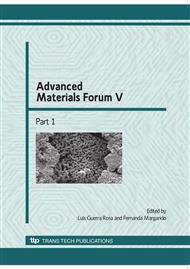[1]
Hollinger, J.O., et al., Role of bone substitutes. Clinical orthopaedics and related research, 1996(324): pp.55-65.
DOI: 10.1097/00003086-199603000-00008
Google Scholar
[2]
Hench, L.L., Bioceramics: from concept to clinic. Journal of the American Ceramic Society, Vol. 74(7) (1991), pp.1487-1510.
DOI: 10.1111/j.1151-2916.1991.tb07132.x
Google Scholar
[3]
Hench, L.L. and J. Wilson, An introduction to bioceramics. 1993: World Scientific.
Google Scholar
[4]
Franco, J., et al., Procesamiento cerámico de ß-TCP para la fabricación de piezas implantables. Editores Asociados.
DOI: 10.3989/cyv.2006.v45.i4.283
Google Scholar
[5]
Saadi, L., et al., Synthesis of mullite precursors in molten salts. Influence of the molten alkali nitrate and additives. Journal of the European Ceramic Society, Vol. 19(4) (1999), pp.517-520.
DOI: 10.1016/s0955-2219(98)00220-9
Google Scholar
[6]
Franco J., G. -T.E., Guitián F. Obtención de monocristales de fosfato cálcico en sales fundidas a partir de β-TCP. in IX Congreso . acional de Materiales. Perspectiva de la investigación sobre materiales en España en el siglo XXI. 2006. Vigo, España: Servicio de Publicaciones de la Universidad de Vigo.
DOI: 10.7764/cdi.29.247
Google Scholar
[7]
Tas, A.C., Molten salt synthesis of calcium hydroxyapatite whiskers. Journal of the American Ceramic Society, Vol. 84(2) (2001), pp.295-300.
DOI: 10.1111/j.1151-2916.2001.tb00653.x
Google Scholar
[8]
Rendon-Angeles, J.C., et al., Effect of metal ions of chlorapatites on the topotaxial replacement by hydroxyapatite under hydrothermal conditions. Journal of Solid State Chemistry, Vol. 154(2) (2000), pp.569-578.
DOI: 10.1006/jssc.2000.8888
Google Scholar
[9]
Rendon-Angeles, J.C., et al., Topotaxial conversion of chlorapatite and hydroxyapatite to fluorapatite by hydrothermal ion exchange. Chem. Mater, Vol. 12(8) (2000), pp.2143-2150.
DOI: 10.1021/cm990797x
Google Scholar
[10]
García-Tuñón E., F.J., Dacuña B., Zaragoza G., Guitián F., Obtención y caracterización de monocristales de fosfatos cálcicos empleando el método de asles fundidas. Bol. Soc. Esp. Ceram. V., Vol. 48(2) (2009), pp.53-64.
Google Scholar
[11]
Altomare, A., et al., SIR97: a new tool for crystal structure determination and refinement. Journal of Applied Crystallography, Vol. 32(1) (1999), pp.115-119.
Google Scholar
[12]
Sheldrick, G.M., SHELX97-Programs for Crystal Structure Analysis (Release 97-2). University of Göttingen, Germany, (1998).
Google Scholar
[13]
Le Bail, A., H. Duroy, and J.L. Fourquet, Ab-initio structure determination of LiSbWO? 6 ? by X-ray powder diffraction. Materials Research Bulletin, Vol. 23(3) (1988) pp.447-452.
DOI: 10.1016/0025-5408(88)90019-0
Google Scholar
[14]
White, T.J. and Z.L. Dong, Structural derivation and crystal chemistry of apatites. Acta Crystallographica Section B: Structural Science, Vol. 59(1) (2003) pp.1-16.
Google Scholar
[15]
Kim, J.Y., et al., Powder diffraction studies of synthetic calcium and lead apatites. Australian Journal of Chemistry, Vol. 53(8) (2000) pp.679-686.
Google Scholar


